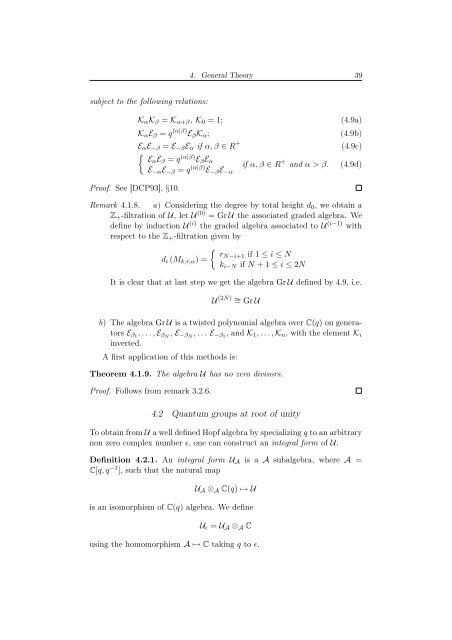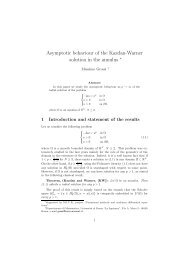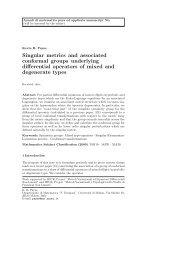Degree of Parabolic Quantum Groups - Dipartimento di Matematica ...
Degree of Parabolic Quantum Groups - Dipartimento di Matematica ...
Degree of Parabolic Quantum Groups - Dipartimento di Matematica ...
Create successful ePaper yourself
Turn your PDF publications into a flip-book with our unique Google optimized e-Paper software.
subject to the following relations:<br />
Pro<strong>of</strong>. See [DCP93], §10.<br />
4. General Theory 39<br />
KαKβ = Kα+β, K0 = 1; (4.9a)<br />
KαEβ = q (α|β) EβKα; (4.9b)<br />
EαE−β = E−βEα if α, β ∈ R +<br />
<br />
EαEβ = q<br />
(4.9c)<br />
(α|β) EβEα<br />
E−αE−β = q (α|β) if α, β ∈ R<br />
E−βE−α<br />
+ and α > β. (4.9d)<br />
Remark 4.1.8. a) Considering the degree by total height d0, we obtain a<br />
Z+-filtration <strong>of</strong> U, let U (0) = Gr U the associated graded algebra. We<br />
define by induction U (i) the graded algebra associated to U (i−1) with<br />
respect to the Z+-filtration given by<br />
<br />
rN−i+1 if 1 ≤ i ≤ N<br />
<strong>di</strong> (Mk,r,α) =<br />
ki−N if N + 1 ≤ i ≤ 2N<br />
It is clear that at last step we get the algebra Gr U defined by 4.9, i.e.<br />
U (2N) ∼ = Gr U<br />
b) The algebra Gr U is a twisted polynomial algebra over C(q) on generators<br />
Eβ1 , . . .,EβN , E−βN , . . . E−β1 , and K1, . . .,Kn, with the element Ki<br />
inverted.<br />
A first application <strong>of</strong> this methods is:<br />
Theorem 4.1.9. The algebra U has no zero <strong>di</strong>visors.<br />
Pro<strong>of</strong>. Follows from remark 3.2.6.<br />
4.2 <strong>Quantum</strong> groups at root <strong>of</strong> unity<br />
To obtain from U a well defined Hopf algebra by specializing q to an arbitrary<br />
non zero complex number ǫ, one can construct an integral form <strong>of</strong> U.<br />
Definition 4.2.1. An integral form UA is a A subalgebra, where A =<br />
C[q, q −1 ], such that the natural map<br />
UA ⊗A C(q) ↦→ U<br />
is an isomorphism <strong>of</strong> C(q) algebra. We define<br />
Uǫ = UA ⊗A C<br />
using the homomorphism A ↦→ C taking q to ǫ.








